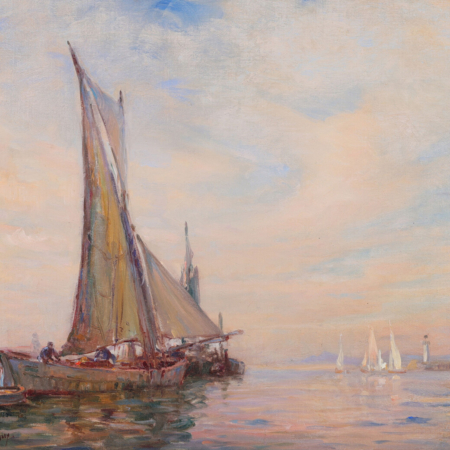
Georges Ricard-Cordingley
He was born on the 30th of January 1873 at Lyon and died on 24th April 1939 at Cannes from a stroke. He was a painter of genre scenes, landscapes with water, marines and portraits.
He was the son of a Frenchman named and an English mother named Cordingley. Ricard, being a relatively common name, decided to hyphenate the surnames to distinguish him and create his own ‘signature’.
From 1887 he became a student of Jean Cazin and from 1888 to 1889 he went to the Ecole des Beaux-Arts de Lyon. He was also a pupil of Jules Lefebvre, Benjamin Constant and the renowned Dutch Impressionist painter J.B. Jongkind. Yet his pieces were inspired by Turner and Constable and their use of light as the critical component in his work.
He had a lot of success at the Salon of French Artists in Paris and at the Royal Academy.
It was under the name of Ricard that he his first pieces were produced. These were generally portraits which caused quite a stir and greatly increased his popularity, exhibiting regularly in Paris and London, and were especially admired by Queen Victoria and the English nobility.
He was only 20 years old when Queen Victoria acquired three paintings for her private apartments.
Until 1901 he had spent much of his time between London and Paris before he decided he needed somewhere to escape from the hustle and bustle of life. So in 1901 he bought a workshop in Boulogne where the inspiration for his maritime works grew stronger than ever before. Soon he became so disenchanted with the life of Paris and London he bought another home in Cannes and from then on his life was mostly based in these two places. Nevertheless he was not afraid to travel and after his early outings to the North Sea at the end of the nineteenth century Cordingley started looking for more ideas further afield. From 1909 – 1910 he went to and spent time in Australia and from 1928 – 1935, not only did he travel in France but he also travelled to Holland, Italy, Switzerland and North Africa.
He was known as the painter of the sky and the sea, the edges where sand meets sea, of maritime images, and shipping activities associated with ports and coastlines. He is acknowledged as a master of seascapes. It was said about him that he knew more ways of painting blue and grey than any other artist. Ricard-Cordingley had the unique ability to render the most subtle nuances of the fog of the Northern Seas, the reflection of the sun on the Mediterranean and the glistening of the moon on the oceans waves.
His works are currently seeing a significant revival and he is the object of numerous publications and exhibitions. They have become very rare on the market since a large part of them was destroyed in 1940 in his studio’s fire.
He has figured in a number of Museums in France:
The National Maritime Museum in Paris, the Museum of Modern Art in Paris, Boulogne, Toulon, Cannes, Castre, Menton, Berck-sur-Mer and Touquet Museum.
He also has pieces in the Queen’s Royal Collection, Philadelphia Museum of Art, the Pushkin Museum of Fine Arts in Russia and the Museum of Casablanca in Morocco.
The last two exhibitions of national importance devoted to his work in France were presented in Toulon in the National Maritime Museum and Brest.
Click on the images below to view and purchase our paintings by Georges Ricard-Cordingley…
- Display 24 Products per page

